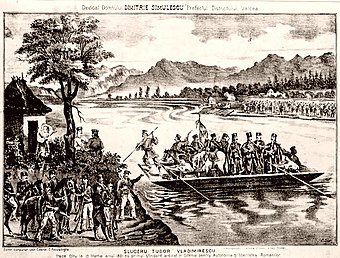 Global Information
Global InformationWallachian uprising of 1821 information
| Wallachian uprising | ||||||||
|---|---|---|---|---|---|---|---|---|
| Part of the Greek War of Independence | ||||||||
 Pandurs crossing the Olt River at Slatina, on May 10, 1821; the four men standing at the front of the barge are, from the left: Dimitrie Macedonski, Tudor Vladimirescu, Mihai Cioranu, and Hadži-Prodan. Lithograph by Carol Isler | ||||||||
| ||||||||
| Belligerents | ||||||||
|
|
|
| ||||||
| Commanders and leaders | ||||||||
|
|
|
| ||||||
| Strength | ||||||||
| 4,000 to 24,000 | 7,000 to 20,000+ |
≈32,000 (10,000 to 14,000 in Wallachia) ≈1,800 Arnauts and allies 1,000 Zaporozhian Cossacks ≈40 ships | ||||||
The uprising of 1821 was a social and political rebellion in Wallachia, which was at the time a tributary state of the Ottoman Empire. It originated as a movement against the Phanariote administration, with backing from the more conservative boyars, but mutated into an attempted removal of the boyar class. Though not directed against Ottoman rule, the revolt espoused an early version of Romanian nationalism, and is described by historians as the first major event of a national awakening. The revolutionary force was centered on a group of Pandur irregulars, whose leader was Tudor Vladimirescu. Its nucleus was the Wallachian subregion of Oltenia, where Vladimirescu established his "Assembly of the People" in February.
From the beginning, Pandurs were joined by groups of Arnauts and by veterans of the Serbian Revolution. Although infused with anti-Hellenism, they collaborated with, and were infiltrated by, agents of the Filiki Eteria. Vladimirescu also cooperated with the Sacred Band of Alexander Ypsilantis, thereby contributing to the larger war of Greek independence. In conjunction with Ypsilantis' troops coming in from Moldavia, Vladimirescu managed to occupy Bucharest in March. Vladimirescu agreed to split the country with Ypsilantis, preserving control over Oltenia, Bucharest, and the southern half of Muntenia. The Pandurs' relationship with the Sacred Band degenerated rapidly, upon revelations that the Russian Empire had not validated Ypsilantis' expedition, and also over Vladimirescu's attempts to quell Eterist violence. Many of the Arnauts openly or covertly supported Ypsilantis, while others endorsed an independent warlord, Sava Fochianos.
Vladimirescu secretly negotiated an entente with the Ottomans, who ultimately invaded Wallachia in late April. The Pandurs withdrew toward Oltenia, which put them at odds with the Sacred Band. Vladimirescu's brutality alienated his own troops; in turn, this rift allowed the Greek revolutionaries to arrest and execute Vladimirescu, unopposed. The Oltenians scattered, though some Pandurs formed pockets of resistance, led by captains such as Dimitrie Macedonski and Ioan Solomon. They suffered clear defeat in their confrontation with the Ottoman Army. In June, Ypsilantis' force and its remaining Pandur allies were routed at Drăgășani. The uprising sparked a cycle of repressive terror, with a final episode in August, when Fochianos and his Arnauts were massacred in Bucharest.
The uprising of 1821 is widely seen as a failed or incomplete social revolution, with more far-reaching political and cultural implications. The Ottoman government registered its anti-Phanariote message, appointing an assimilated boyar, Grigore IV Ghica, as Prince of Wallachia. The ascent of nationalist boyars was enhanced during the Russian occupation of 1828, and cemented by a new constitutional arrangement, Regulamentul Organic. During this interval, survivors of the uprising split between those who supported this conservative establishment and those who favored liberal causes. The latter also helped preserve a heroic image of Vladimirescu, which was later also borrowed by agrarianists and left-wing activists.